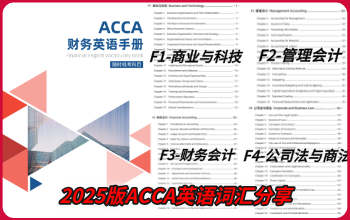
Sources [Kaplan,BPP,LSBF,Beckers Professional,First Intuition,MM University]
ACCA F7 Financial Reporting Paper Exam Tips for December 2015 Session are given below by famous tuition providers
Kaplan
MCQ’s can come from any syllabus area.
Consolidation of Financial Statements
For the consolidation question(Q1)you will benefit from having the proforma/standard workings of your final answer set up first.For example if the question requires a consolidated SFP then drawing up the SFP with open brackets beside those numbers that do not need a standard working can get all the easy adding across 100%of the Parent and subsidiary figures.The other headings can have the standard working number written beside them instead.A couple of lines would need to be left for each section of the SFP in case other things come up in the additional information.
In addition to this setting up the standard workings can also be done.The subsidiaries’share capital figures and the year end retained earnings can be put into these without reading any of the additional information.In addition to this the parents retained earnings figure can also be put into W5(Retained earnings)without reading any additional narrative.
With all of the proformas and standard workings set up,it means that you are able to tackle the issues in the order that they are presented in the question.It also allows you to deal with both sides of any adjustments as everywhere is set up to make the adjustments.It hopefully prevents non-balancing accounts and means that each issue only has to be addressed once;thus helping with time management.Also if you run out of time,you will get full credit for all that you have already done provided everything is referenced through.
A similar process can be applied to the income statement equivalent of setting up final answer and workings to help tackle the issues that come up.
Single Company Financial Statements
Single company financial statements(question 2).As with the groups question,it may be possible to get the proforma of the final answer set up,particularly if the data in the question is set up with the draft financial statements rather than the trial balance.If possible it then means that open brackets can be used and the draft figures placed in them,ready for adjustments as they arise.Generally speaking there are often more adjustments required for cost of sales figure in the income statement and the PPE figure in the SFP.As such I would suggest these are likely to need separate workings rather than just a bracket beside the final answer.
If there is a topic/adjustment that you are unsure of,come back to it.You are better to get the adjustments that you are comfortable with done first.It is easy to get bogged down and waste time on a difficult adjustment at the expense of doing an easier one that appears later in the question.
Performance Appraisal
With a performance appraisal question you may be asked to calculate ratios or prepare a statement of cash flow or both.When calculating ratios,if you are unsure of a particular calculation always have a go,as even if the calculation is incorrect you will be awarded merit for your discussion of the incorrect number in the written section of the question.It also really helps the marker if you note your formula down so that your working is clearly identified.
When preparing a statement of cash flow setup you proforma immediately and begin to get the easy marks in the cash flow such as finding the movement in the cash and cash equivalent balance,and finding the movements on basic shares and loans.You will also find the operating activities section familiar and useful for scoring marks.If there are any cash items that you are unfamiliar with come back to these at the end after you have dealt with the items that you can do.
Finally,when appraising the performance of a company ensure that you always refer to the scenario provided to ensure maximum credit is awarded.
BPP
Q1&Q2:One likely to be an interpretation or statement of cash flows;the other may be a consolidation question if Q3 is not a consolidation.
Other possibilities–conceptual framework,intangible/tangible assets and impairment,provisions and contingencies,revenue and grants,financial instruments discontinued operations/assets held for sale or earnings per share.
Q3:could be a single entity or a consolidation(statement of profit or loss and other comprehensive income and/or statement of financial position).
Statement of changes in equity,statement of cash flow extract,earnings per share calculation or linked written topic.
Consolidation question with adjustments,eg fair values,deferred/contingent consideration,PUP on inventories/PPE,intragroup trading and balances,goods/cash in transit.
LSBF
Read the entire question paper during the 15 minutes reading time and choose to do the your best question first helpful for your success.
Question 1: would possibly be Consolidated Statement of Financial Position with an associate that what i think is likely.There were no associate from last two sessions and associates on average come up almost every time.
The other possibility is the Consolidated Statement of Financial Position(CSFP)and Consolidated Income Statement(CIS)as this has come up in December 2008 and December 2009 so that’s in a real competition.Otherwise question one is likely to be Consolidated Statement of Financial Position with an associate.
Question 2: this time would likely to be Published Accounts(Single Entity Financial Statements)with standards but redrafting of Published Accounts have not come up since 2008.So the trial balance with 8 adjustments is the most likely scenario for question 2 but there is also a possibility of redrafting of Published Accounts which have not come up since 2008.
Question 3: could be Statement of Cash Flow with Interpretations and either interpretation exclusively on Cash Flow or it could be half and half brief cash flow and then ratios and then interpretations.
I would include lots of standards 5 or 6 marks from
● Capital Grants
● Investment property
● Provision and contingencies
● Leasing
● Tangible Non Current Assets etc
First Intuition
MCQs on the whole syllabus.
–Extracts from single company accounts including non-current assets,taxation and IFRS 15.
–Interpretation of accounts including a statement of cash flows.
–Consolidated SFP and/or SPL with associate,PUP and fair value adjustments.
Open Tuition
Section A–Multiple Choice Questions
● do not waste time doing neat workings for calculation questions–your workings will not be marked.Only the answer on the answer sheet is marked.
● look first for the short questions and those on topics you feel most happy with.All the questions carry 2 marks so don’t waste time on a question that requires a lot of reading–come back to it later when you have finished the shorter questions.
● if you come across a question that you know nothing about,then staring at it will not make any difference–guess an answer and move on(there is a chance you may have guessed correctly).
● watch your time.You should spend 72 minutes on Section A and no longer.You can always go back to it later if you find you have time left after completing
Section B–long form questions
● keep your eye on the clock and when there is 5 minutes left before the end of the exam stop what you are doing,and guess any of the Section A questions that you have not answered.You must make sure that you hand in answers to all 20 questions even if it means guessing several of them.
● make sure you write something for every part of every question.You are unlikely to be able to finish every part of every question–either because you run out of time or you get stuck–but you can always write something.In the calculations each part of the workings is marked separately,whether or not you have finished.In the written parts,each comment is marked separately.Even if you can only think of one brief comment and get just one mark,that could turn a 49%fail into a 50%pass.
● for calculation parts of questions,show your workings neatly.It is the workings that get the marks(whether the final answer is right or wrong)but the marker can only give you the marks if they can follow what you have done
● for the written parts of questions,make sure that you writing is legible.(Before the exam day,ask someone if they can read your writing easily–if they can’t then consider printing the words!)
● for the written parts of questions,write each separate point on a new line(with a line space between points).If you write one long paragraph containing several points,then there is a danger that the marker will miss some of the points.
● allocate your time.You should allow 27 minutes for each 15-mark question,and 54 minutes for the 30-mark question.There are 3 questions and submitting 3 answers all part finished,will get you more marks than only submitting 2 answers and missing one question completely.
● start each part of each question on a new page in the answer booklet(if you run out of pages you will be provided a supplementary booklet!).That way you can always go back to questions and be able to add more to your answer neatly,if you have time left at the end of the exam.
Do make sure you make it clear at the top of the page which part of which question you are answering.
● where a question has two sections,part a)and part b),and the second part is not dependent upon arriving at an answer in part a),then do part b)first.Part b)tends to be 5–8 marks of relatively easy chat yet is most frequently ignored by students.This is often as a result of the time pressure and the desire to“just balance that statement of financial position”.Very simply,you will only rarely get to part b)unless you do it before part a)
● for a written answer,be aware of just how many marks are available and plan sufficient points to include within your answer to get the majority of those marks.Remember,one correct point earns one mark.
● also be aware of just how much you can write in 1 minute 18 seconds(that’s 1 minute 48 seconds net of 30 seconds planning time per point).Get a friend to time you as you copy from a book or magazine and see what the maximum length of your points should be–probably no longer than 3 lines for each separate point



 考前TIPS
考前TIPS
 发布时间:2016-10-27
发布时间:2016-10-27


 复制本文链接
复制本文链接 模拟题库
模拟题库

 323
323

























